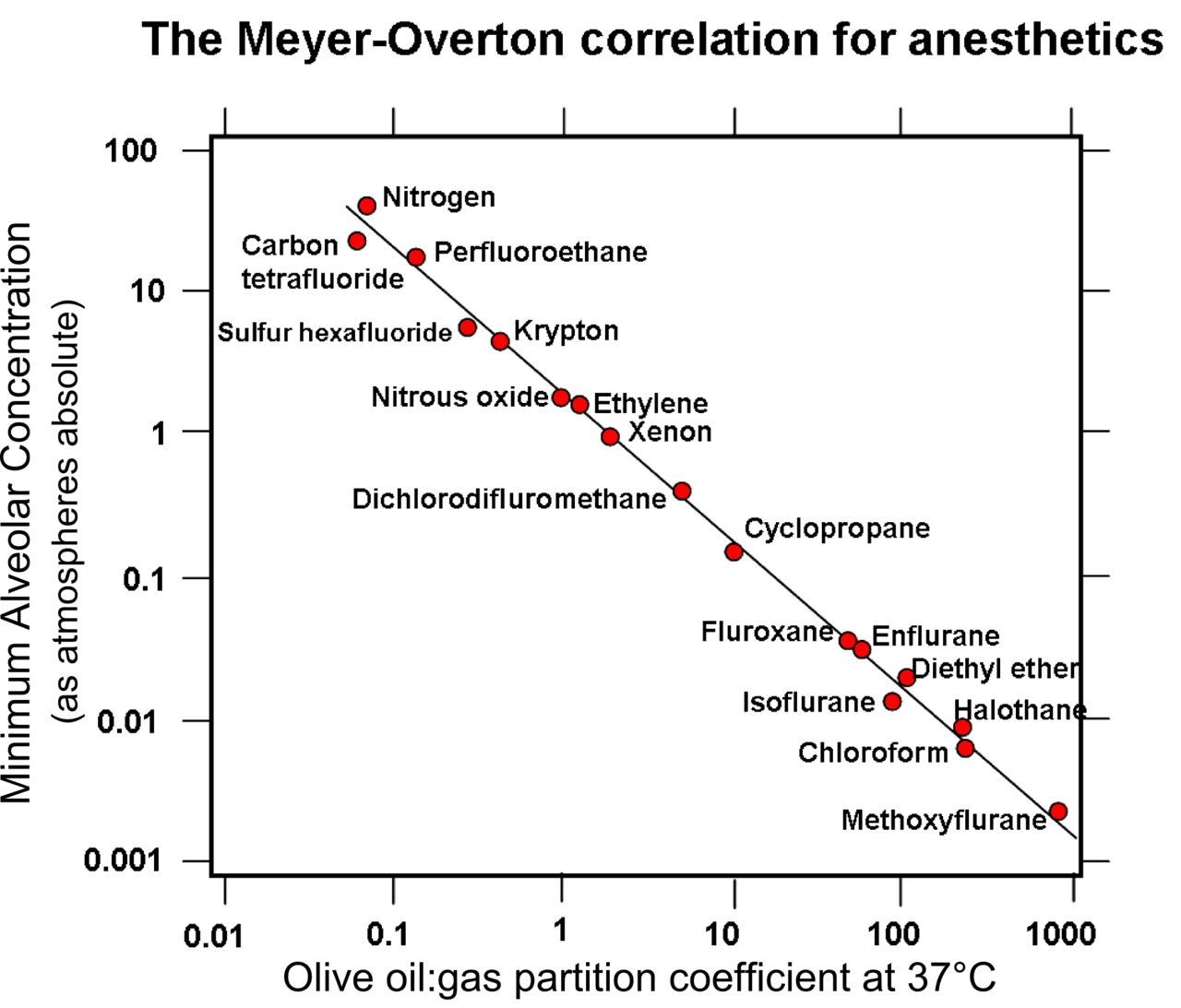Such_Saturation
Member
- Joined
- Nov 26, 2013
- Messages
- 7,370
https://en.wikipedia.org/wiki/Theories_of_general_anaesthetic_action#Modern_lipid_hypothesis said:according to the modern lipid hypothesis anaesthetics do not act directly on their membrane protein targets, but rather perturb specialized lipid matrices at the protein-lipid interface, which act as mediators. This is a new kind of transduction mechanism, different from the usual key-lock interaction of ligand and receptor, where the anaesthetic (ligand) affects the function of membrane proteins by binding to the specific site on the protein. Thus, some membrane proteins are proposed to be sensitive to their lipid environment.

The concept of specific interactions between receptors and drugs first introduced by Paul Ehrlich[1] states that drugs act only when they are bound to their targets (receptors). However, this concept does not seem to apply in the case of general anaesthetics because:
All these common features of general anaesthetics made it hard for early researchers to believe that general anaesthetics act in a specific manner and their action on neuronal membrane was thought to be global (through nonspecific perturbation of lipid membrane of CNS neurons) rather than through specific sites.
- Molecular structures of general anaesthetics widely used in medicine are very simple and diverse so that there is no obvious structure–activity relationship[1] (see structures of general anaesthetics widely used in medicine: 1 - ethanol, 2 - chloroform, 3 - diethyl ether, 4 - fluroxene, 5 - halothane, 6 - methoxyflurane, 7 - enflurane, 8 - isoflurane, 9 - desflurane, 10 - sevoflurane)
- Most general anaesthetics have remarkably weak affinity for their targets acting at much higher concentrations than most other drugs so that diverse side effects are inevitable.[citation needed]
Meyer and Overton had discovered the striking correlation between the physical properties of general anaesthetic molecules and their potency: the greater is the lipid solubility of the compound in olive oil the greater is its anaesthetic potency.
But still Ray Peat wouldn't like this too much. In fact if you keep reading the wikipedia it goes back to proteins (Ray Peat, Gilbert Ling, Stuart Hameroff, etc.):
In the early 1980s, Franks and Lieb[34] demonstrated that the Meyer-Overton correlation can be reproduced using a soluble protein. They found that two classes of proteins are inactivated by clinical doses of anaesthetic in the total absence of lipids. These are luciferases, which are used by bioluminescent animals and bacteria to produce light,[35] and cytochrome P450,[36] which is a group of hemeproteins that hydroxylate a diverse group of compounds, including fatty acids, steroids, and xenobiotics such as phenobarbital. Remarkably, inhibition of these proteins by general anaesthetics was directly correlated with their anaesthetic potencies. Luciferase inhibition also exhibits a long-chain alcohol cutoff, which is related to the size of the anaesthetic-binding pocket.
It was initially hypothesized that general anaesthetic binds to its target ion channel by a key-lock mechanism and changes its structure dramatically from open to closed conformation or vice versa. However, there is a significant amount of evidence against direct key-lock interaction of membrane proteins with general anaesthetics
This aspect is also of relevance to Ray Peat:
General anesthetics inhibit cytochrome P450 monooxygenases and arachidonic acid metabolism. - PubMed - NCBI
The universal cytochrome P450 monooxygenases, in conjunction with other lipid oxygenases (cyclooxygenases and lipoxygenases) participate in the second messenger AA cascade.
Interactions of the anesthetic nitrous oxide with bovine heart cytochrome c oxidase. Effects on protein structure, oxidase activity, and other prop... - PubMed - NCBI
Cytochrome c oxidase inhibition by anesthetics: thermodynamic analysis. - PubMed - NCBI
http://raypeat.com/articles/articles/natural-estrogens.shtml said:The presence of an external metabolizing system, such as rat liver homogenates (S9 mix), leads to an increase in its genotoxicity, which is attributed to its biotransformation to the more genotoxic flavonoid quercetin, via the cytochrome P450 (CYP) mono-oxygenase system.”
http://raypeat.com/articles/articles/osteoporosis-aging.shtml said:Copper, which is the co-factor for the cytochrome C oxidase enzyme, activated by thyroid, is essential for bone formation and maintenance, and is consistently deficient in osteoporosis. Thyroid hormone increases the body's ability to assimilate copper.
Aspirin, which stimulates bone formation, has other thyroid-like actions, including activation of mitochondrial respiration and energy production, with an increase of cytochrome C oxidase (Cai, et al., 1996), and it lowers serotonin (Shen, et al., 2011).
http://raypeat.com/articles/aging/a1.shtml said:Cytochrome oxidase is one of the enzymes damaged by stress and by blue light, and activated or restored by red light, thyroid, and progesterone. It's a copper enzyme, so it's likely to be damaged by excess iron. It is most active when it is associated with a mitochondrial lipid, cardiolipin, that contains saturated palmitic acid; the substitution of polyunsaturated fats lowers its activity. Mitochonrial function in general is poisoned by the unsaturated fats, especially arachidonic acid and DHA.
http://raypeat.com/articles/articles/alzheimers.shtml said:Thymidine and cytidine, which are pyrimidine-based, are endogenous analogs of the barbiturates, and like them, they might be regulators of the cytochrome P450 enzymes.
http://raypeat.com/articles/nutrition/carrageenan.shtml said:Carrageenan contributes to the disappearance of the liver enzymes (the cytochrome P-450 system) that detoxify drugs, hormones, and a variety of other chemicals.
So bad but also maybe good

Intravenous anesthetic propofol suppresses prostaglandin E2 production in murine dendritic cells. - PubMed - NCBI
Oxidative metabolism in fetal rat brain during maternal halothane anesthesia. - PubMed - NCBI
